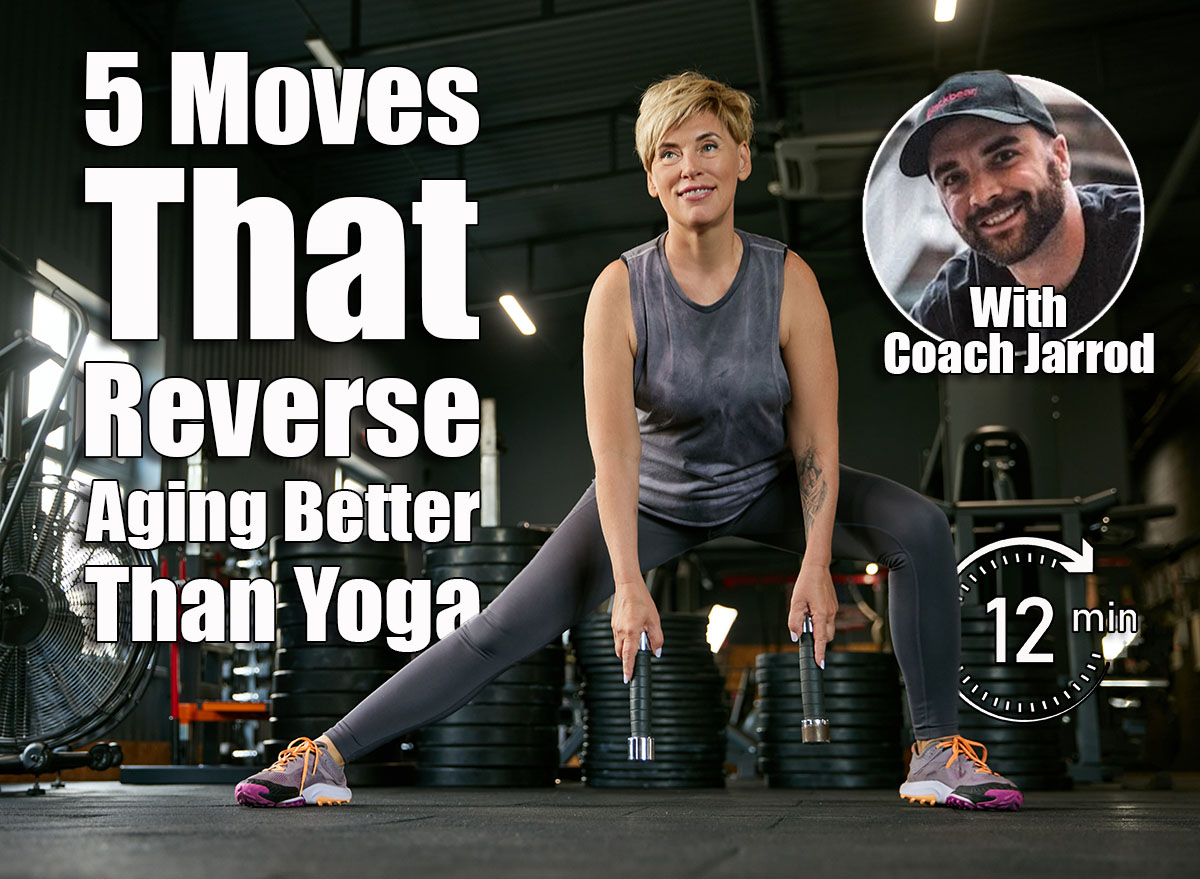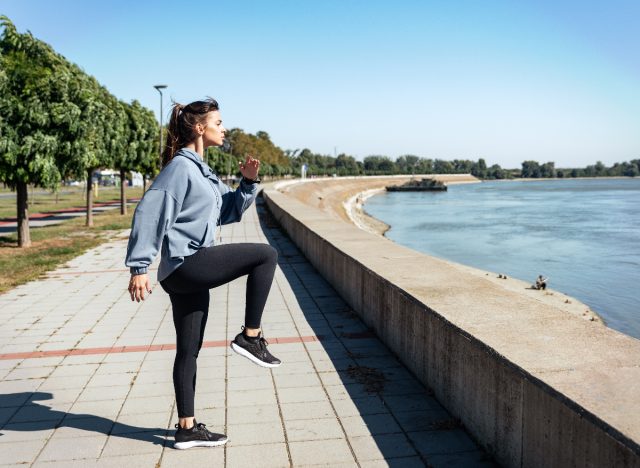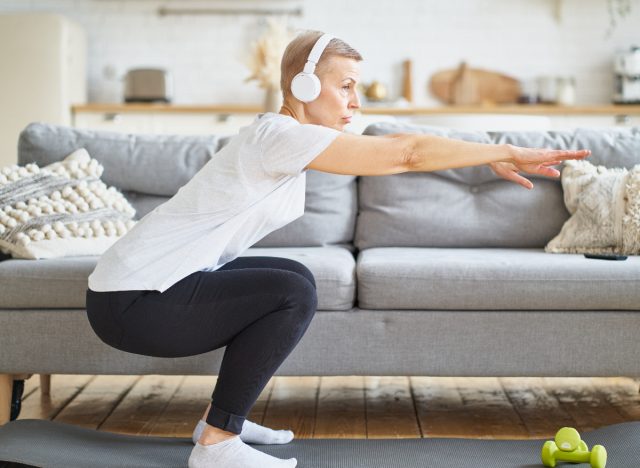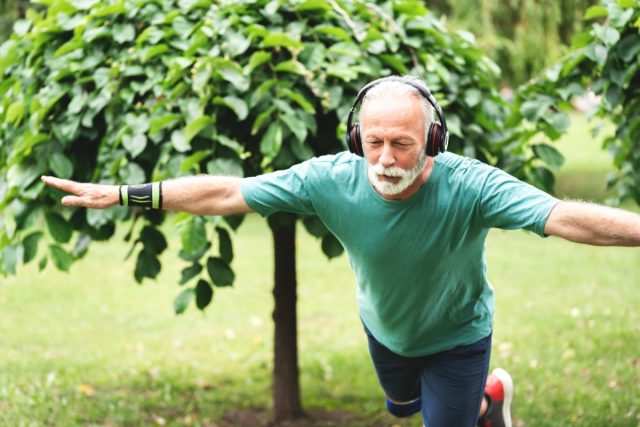5 Simple Movement Tricks That Reverse Aging Better Than Yoga, Say Experts

Yoga is a wonderful practice for restoring the mind and mobilizing your body. But to be fair, Yoga might not be everyone’s cup of tea. If you favor the non-Yoga styles of restorative practices, I’ve got something for you.
In my years coaching athletes, everyday clients, and older adults, I’ve seen what works to improve movement and turn back the clock. You can forget about longer workouts or more yoga classes that might make you feel more uncomfortable than comfortable by practicing smarter movements that restore control, strength, and coordination throughout your entire body.
The five tricks below are simple, but they aren’t fluff. They target the exact movement qualities that decline with age and rebuild the stability, strength, and agility that help you feel capable in your body. I’ve used every one of these with clients and in my training to reinforce function in the places that matter most: hips, core, knees, and spine.
You can work them into your warm-ups, recovery days, or strength workouts. You can even do some of them in your living room in under 10 minutes. However, don’t mistake simplicity for ease. These movements work best when done with complete focus, quality form, and consistency over time.
Movement Trick #1: Controlled Step-Downs: Build Knee Strength and Lower Body Control

Step-downs develop stability, strength, and control through the knees, glutes, and hips. They also help improve balance and reduce the risk of falls. Over time, this movement improves eccentric strength, which is the ability to control motion and absorb force—a key skill that protects your joints and prevents stumbles or sudden drops during daily life.
Muscles Trained: Quadriceps, glutes, calves, hip stabilizers
How to Do It:
- Stand on a low step or sturdy box, with one foot on the step and the other hanging off.
- Keep your hips square and chest tall.
- Slowly lower your free leg until your heel lightly taps the floor.
- Keep your standing knee tracking over your toes.
- Push through your standing heel to return to the top.
- Repeat all reps on one leg before switching to the other side.
Recommended Sets and Reps: Perform 3 sets of 6 to 10 reps per leg. Rest for 45 to 60 seconds between each set.
Best Variations: Weighted step-down, deficit step-down, lateral step-down
Form Tip: Control the descent for at least 3 seconds and avoid collapsing through the hips.
Movement Trick #2: Cross-Crawls: Reconnect Coordination and Core Stability

Cross-crawls reinforce coordination between your upper and lower body while waking up your core and posture muscles. They also stimulate the nervous system and reintroduce cross-lateral movement patterns that can often become lost with age or a lack of variety in training. This improves your ability to move fluidly, stay balanced, and respond to your environment.
Muscles Trained: Obliques, hip flexors, deltoids, spinal stabilizers
How to Do It:
- Stand tall with your feet hip-width apart.
- Lift your right knee and tap it with your left hand.
- Lower your foot and repeat on the opposite side.
- Continue alternating sides at a slow, rhythmic pace.
- Keep your core braced and spine tall throughout.
Recommended Sets and Reps: Perform 2 sets of 20 to 30 reps (10 to 15 per side). Rest for 30 to 45 seconds between sets.
Best Variations: Seated cross-crawls, standing weighted cross-crawls, crawling on hands and knees
Form Tip: Move with intention, not speed. Keep your torso from twisting too much side to side.
Movement Trick #3: Deep Squat Hold: Restore Natural Hip and Ankle Mobility

Spending time in a deep squat teaches your hips, ankles, and spine to move the way they were built to. It improves joint health and posture and prepares your body for stronger lower-body movements. This daily position also reconditions your connective tissue, decompresses the spine, and helps you reclaim a fundamental human posture that supports long-term mobility.
Muscles Trained: Glutes, adductors, calves, spinal erectors
How to Do It:
- Stand with your feet shoulder-width apart and toes slightly out.
- Sink your hips into a deep squat position.
- Keep your heels on the ground and your chest lifted.
- Hold the position for a time while keeping tension through your legs.
- Use a support (pole, doorframe, strap) if needed to maintain balance.
Recommended Sets and Reps: Perform 3 holds of 30 to 60 seconds. Rest for 30 seconds between each hold.
Best Variations: Goblet squat hold, TRX-supported squat hold, deep squat with reach
Form Tip: Keep your heels down and knees tracking over your toes. Let your hips sink between your ankles.
Movement Trick #4: Side Lunges: Strengthen Lateral Movement and Hip Stability
Lateral strength is often overlooked, but it’s essential for maintaining hip control and preventing injury. Side lunges improve joint alignment, balance, and flexibility in your hips and inner thighs. Adding lateral work also strengthens the supporting muscles around the knees and hips, providing better support during dynamic activities such as hiking, sports, or quick directional changes.
Muscles Trained: Glute medius, adductors, quadriceps, hamstrings
How to Do It:
- Stand with your feet together and your chest tall.
- Step out to the right, keeping your left leg straight and your right leg bent.
- Push your hips back and bend your right knee as you sink into the lunge.
- Keep your foot flat and your knee aligned over your toes.
- Push through your right foot to return to standing.
- Repeat all reps on one leg before switching to the other side.
Recommended Sets and Reps: Perform 3 sets of 6 to 8 reps per leg. Rest for 45 to 60 seconds between each set.
Best Variations: Lateral band walks, dumbbell side lunge, sliding disc lateral lunge
Form Tip: Step wide enough to feel a stretch in the inner thigh, but keep control through your hips.
Movement Trick #5: Hinge-and-Reach: Train the Posterior Chain and Improve Posture

A solid hip hinge restores strength throughout the back of your body while correcting the forward-leaning posture that often develops with age. It also promotes balance and overall body awareness. Training this pattern teaches you how to load the hips properly, rather than the lower back, which reduces strain, improves lifting mechanics, and builds foundational power for everyday movement.
Muscles Trained: Glutes, hamstrings, spinal erectors, lats
How to Do It:
- Stand with your feet hip-width apart and arms at your sides.
- Shift your hips back while reaching your arms forward.
- Keep a flat back and a soft bend in your knees.
- Lower your torso until it’s nearly parallel to the ground.
- Drive through your heels to stand tall and return your arms to your sides.
Recommended Sets and Reps: Perform 3 sets of 8 to 12 reps. Rest for 45 to 60 seconds between each set.
Best Variations: Single-leg hinge, resistance band pull-through, kettlebell good morning
Form Tip: Push your hips back first, not your knees forward. Keep your spine long and neutral.
The Best Tips for Reversing Aging Through Movement and Mobility
Proper habits can restore energy, improve posture, and keep you strong and mobile long after most people start to slow down. Below are some of the best movement and mobility tips I share with clients to reinforce the gains made through simple but powerful exercises like the ones above:
- Move every day, even if it’s just for 10 minutes: Consistency trumps intensity when it comes to longevity. Daily low-intensity movements, such as walking, crawling, or mobility flows, help keep your joints lubricated and muscles activated.
- Train all directions, not just forward and backward: Add in lateral, rotational, and cross-body movements to maintain full-body function and coordination.
- Sit less, squat more: Break up long periods of sitting by squatting, hinging, or doing a few bodyweight movements. This helps reset posture and reinforces natural movement patterns.
- Prioritize control over speed: Slower, more intentional reps build awareness, stability, and strength in the muscles that matter for aging well.
- Breathe through your nose and engage your core: Good breathing mechanics and core control influence how well your spine moves and how stable you feel during motion.
- Warm up your ankles and hips before training: These two joints control a massive amount of your movement capacity. Mobilizing them first makes everything else easier and more efficient.
- Use movement screens or self-assessments: Check in with how your body moves. Can you balance on one foot, rotate through your thoracic spine, or hinge at the hips without compensation?